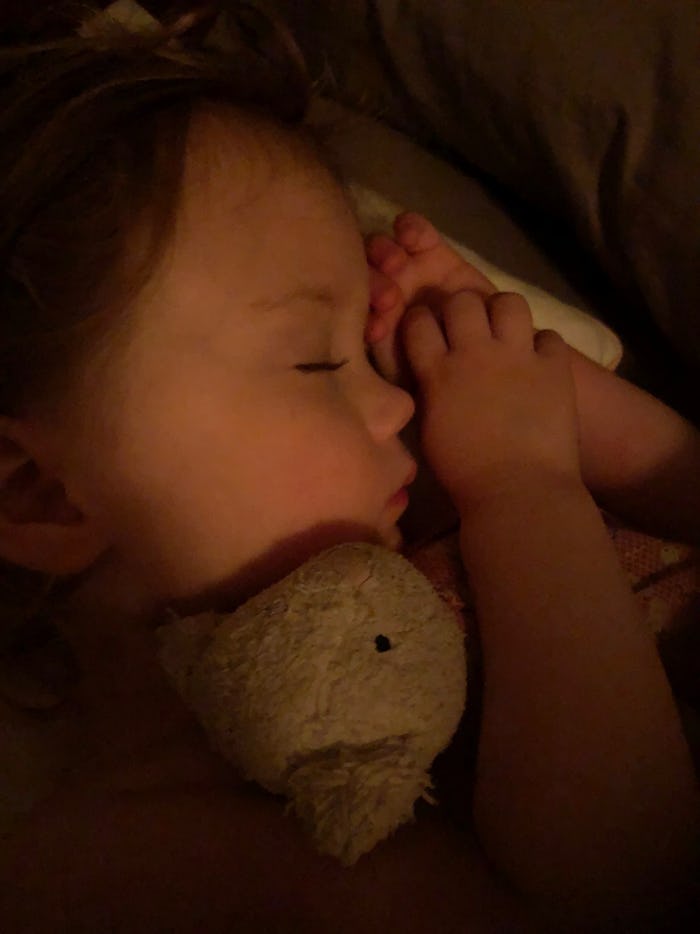Life

Don't Just Choose Any Stuffed Toy — Here's How To Pick The Perfect Lovey For Your Kid
My husband and I have what we call Brave Little Toaster syndrome. It's our theory that the '80s Disney movie that assigned feelings and personalities to inanimate objects officially scarred us for life. To this day, our 33-year-old selves will see a stuffed animal on the side of the highway and not only mourn the fact that it lost its human, but that we can't cross four lanes of moving traffic to rescue it. When we had our daughter Claire, we had no idea how to choose a lovey that was a safe and comfortable choice for her, but we knew it was inevitable she would cling to something given her lineage. Still, we weren't sure: What was the best choice for her?
"Parents should consider items that are not just cute, but also comfy and comforting," Dr. Tiffany McKinnon-Russell, founder of Thoughts of a Homeschool Mom, tells Romper in an email interview. "A stuffed animal may seem cute to an adult, but could be frightening to a child. Whenever possible, test out the item before you buy it (i.e., let your child hold or experience the item in the store) to see how they respond."
Not sure exactly what constitutes as a lovey? Turns out, anything you want. According to The Baby Sleep Site, a lovey can be anything that’s safe for a child to have at bedtime, including a small stuffed animal, throw pillow, blanket, pacifier, board book, and even a hair extension.
Melanie Potock, pediatric feeding expert and co-author of Raising a Healthy, Happy Eater, tells Romper safety measures to keep in mind include making sure that "stuffed animals, blankies or other lovies have no buttons, pom-poms or other small choking hazards that can come loose or be put in the mouth."
McKinnon-Russell agrees, adding that the size of the item should be considered if your child will be sleeping with the item at night or during naps. "You want to ensure that the child's breathing will not be obstructed in any way during sleep, and no injuries will be sustained as a result of having difficulty carrying, holding, or lifting the item," she says.
Also important? "Buy 3 of whatever you choose," Potock says. "One for the child to use, another for when that one gets dirty, and a third to keep when one gets lost." Take it from me: This point is important to keep in mind. I had no idea that when Claire finally landed on the lovey of her choice, Jellycat would screw me over and stop making it. Where were you when I needed you, Melanie? I have scoured toy stores and eBay auctions to no avail, and have now simply resorted to praying Kitty doesn't lose his head because the threadbare material holding it atop his shoulders finally gives out.
Don't be surprised, Potock says, if you eventually need to reduce the size of a lovey so that your little one can have a piece of a favorite blanket or stuffed animal in their pocket when they eventually go to preschool or kindergarten. "For children who need extra comfort, a piece of the lovey can be sewn into one pocket of a few pairs of pants," she says. "Then, when he reaches in his pocket, he’ll feel the soft piece of fabric and know that everything is OK."
Of course, if you're kid is like mine, then the lovey will be making outings and appearances long before the school years hit. Kitty is a regular at the dinner table and even has a spot in our gym locker — complete with provisions like a sippy cup and snacks — when Claire heads to swim class.
Allison Klein, owner of New York-based Rose & Rex, says choosing the right materials is also crucial when introducing your little one to a lovey. "Look for organic, natural materials instead of synthetic fabrics that may irritate baby’s skin," she tells Romper in an email interview. I can tell you firsthand that choosing the right materials is also important because you are bound to be washing that lovey at least 88 times per month. Klein recommends adorable loveys, like Organic Hazel Village Annicke Mouse and Wise Old Owl Lovey, as options that will not only provide comfort, but "a rich sensory experience.
"You want baby to be able to touch, grasp and interact with his/her lovey so that they develop early motor skills, which is why choosing the right size can make a difference," Klein says. "What starts as a comfort object today will grow with your toddler into a friend for imaginative play adventures and much more."
Which is something that this Brave Little Toaster mama will cherish no matter how many years go by.
Check out Romper's new video series, Romper's Doula Diaries:
Watch full episodes of Romper's Doula Diaries on Facebook Watch.